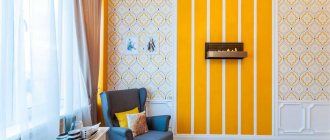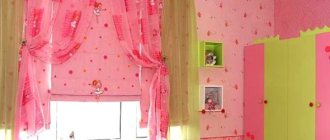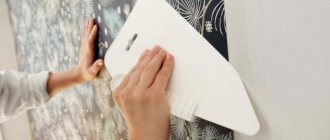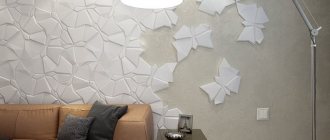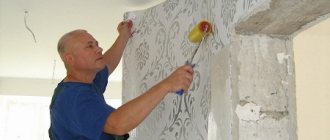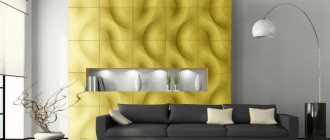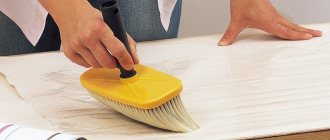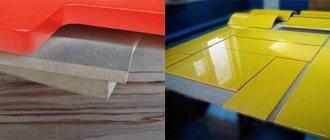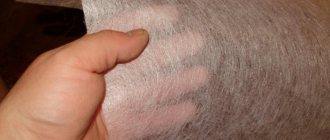Savig
8074 0 6
Savig October 26, 2017Specialization: master of interior finishing works. I am well versed in power tools for repair and construction. Formerly a teacher at a radio engineering college.
With the right approach, when combining panels with wallpaper, you can get an excellent result
Is it possible to glue wallpaper on PVC or MDF panels? In search of answers to this question, I propose to consider the features and instructions for combining these finishing materials. Visual illustrations will help you understand everything.
Is it possible to glue wallpaper on MDF panels?
Share on social media networks:
Sometimes, due to the characteristics of the premises, during interior decoration we are forced to resort to the use of several types of finishing materials at once. This method allows you to focus on the obvious advantages of the interior, hiding some of the disadvantages of the room itself or each of the finishing materials. Today, one of the most popular options is a combination of wallpaper and various panels - PVC, MDF, SIP and others. While some people are just wondering whether it is possible to glue wallpaper on MDF panels, this method of decorating the interior has already proven itself to be effective in both living rooms and non-residential premises. Let's look at this technology in detail.
Conclusions on the topic
Nowadays, queries in search engines are quite popular regarding whether it is possible to glue wallpaper to unprepared surfaces. Of course, any professional will tell you that it is impossible. However, we will say that it is possible, but the result most likely will not suit you. In the event that you decide to glue it to unprepared concrete walls, then it may turn out quite well, but in the case of chipboard, or other materials such as OSB, drywall, etc., all the seams will be visible through the wallpaper and soon the wallpaper may tear.
If you still have questions on the topic, you can ask them in the comments to this article and we or our readers will be happy to answer your questions.
How to glue wallpaper on panels?
Construction hypermarkets and finishing materials markets sell a wide range of different types of decorative panels for finishing walls and ceilings. We will look at the most popular of them, and also answer the question of whether it is possible to glue wallpaper on MDF and similar materials, and how to do it correctly.
PVC wallpaper and trim
Before you start gluing wallpaper in combination with plastic panels, you need to prepare the work surface. Your flow of action should look something like this:
- Prepare all the necessary tools and materials - primer for plastic panels, solvent, sandpaper or its equivalent with fine grain.
- Sand the glossy surface, making it matte where the panel and wallpaper are attached (for better fixation).
- Wipe off any fine dust from the surface of the plastic with a slightly damp cloth and wait until it dries completely.
- Apply a primer that is designed specifically for use on plastic trim.
- Treat the surface using special tools with an adhesive primer with the addition of a solvent.
Surface preparation is complete. Now you can start gluing wallpaper, no longer wondering whether it is possible to glue wallpaper on plastic panels, because the answer will be positive: yes, it is possible!
Panels made from wood products
In many large construction stores you can easily purchase analogues of decorative panels made from woodworking products. They contain ground coniferous wood. Small particles are bonded together by pressing at high temperatures. Thus, MDF panels do not contain “chemicals” such as resin, glue, etc.
Important! Such panels have good heat and sound insulation properties. As a rule, the width of the MDF panel is 58-60 cm, height - 2.5-2.7 m, thickness - 12 mm. Today on sale you can find a wide selection of MDF panels of various colors and textures.
Modern production technology creates light and porous boards with good density, which makes it possible to glue wallpaper or even textiles onto similar MDF panels. In this case, any type of wallpaper can be used - paper, vinyl, fiberglass and others. That is, to the question whether it is possible to glue wallpaper on MDF, the answer will be positive, but under a mandatory condition: the panels must be well primed with a special compound so that they do not absorb all the glue.
Liquid wallpaper and SIP panels
A popular type of finishing today is a combination of SIP panels and liquid wallpaper.
Installation of the latter on decorative surfaces, including SIP panels, is quite simple. However, when using liquid wallpaper in a room with high humidity, it should be additionally treated with a protective layer of a special coating.
In general, liquid wallpaper is a good option for interior decoration. They have excellent performance characteristics, and at the same time have a beautiful appearance thanks to the various inclusions included in the composition. Plus - they are quite easy to install, which even a non-professional can handle, following the instructions.
Preparatory process
Before the preparatory stage, wallpaper is purchased, and then, based on its quality, tools and materials are prepared:
- Glue selected specifically for this type of material and a container for it.
- Brush or paint brush for applying glue.
- Roller for smoothing fabrics.
- Scissors, ruler, pencil, rag.
For wood-based panels, it is better to purchase vinyl, non-woven materials or silk-screen printing. It is these types that will hide unevenness and some deformations of the slabs in the future.
Plane preparation process:
- Treat the chipboard and seal the heads of nails, self-tapping screws and screws with putty.
- Putty the uneven surfaces of the planes with a special mixture for wood.
- Process and seal openings using special meshes.
- If there are old paintings hanging on the walls, then they must be dismantled.
If the old materials are firmly glued, then do not clean them, but coat them with a layer of adhesive solution.
- Prime the entire surface in two layers.
Preparation for priming:
- Thoroughly clean the surface from dust using a vacuum cleaner and damp rags.
- If there are any roughness, then go over it with fine sandpaper.
- Clean the plane again.
Priming is carried out before and after puttying. Each subsequent layer of primer is applied perpendicular to the previous one.
How to combine materials correctly?
There are a huge number of options for combining different finishing materials. Let's look at the features of using the most popular of them when decorating small apartments or country houses.
Geometric combination of finishes
The design of surfaces with alternating vertical or horizontal inserts of wallpaper and panels is suitable for absolutely any room design:
- Fragments can be highlighted by alternating different panels and wallpapers for decoration. The most suitable for this option would be thick vinyl or non-woven wallpaper with relief.
- Stripes can be alternated in different colors - contrasting or solid shades.
- The width of the strips that is optimal for the room should be selected based on the height of the ceiling or the length of the wall.
- The decoration of the corridor and other rooms can clearly demarcate each other with borders, friezes, and moldings. Such material will not only disguise the joints, but also serve as a decorative element.
Application of inserts:
- The first step is to prepare the walls, prime them with a special solution.
- The surface is then wallpapered or paneled.
- Next, the necessary finishing is installed in pre-designated areas.
Important! Inserts can be strips of wallpaper or sections of panels of different shapes and sizes. This method involves decorating some elements with borders or moldings.
Wallpaper inserts over a large area
This method is necessary for finishing different semantic areas in one room, that is, for its zoning. For example:
- When dividing a children's room into a bedroom, play area and study area, you can install panels of calm colors in the area of the bed and desk, and apply brightly colored canvases for the play area.
- For a living room, a good option is to use contrasting panels or wallpaper to highlight a niche with a TV installed.
- In the bedroom, the most commonly used option is to highlight the head of the bed. The best option is a combination of wallpaper and panels that have different shades of the same color.
Application of flaps
This original method of combining finishes is suitable for creating an unusual room design. Here everything is limited only by the imagination of the master. Wallpaper is cut into pieces of various shapes and sizes. Then they are glued to the surface in any order, creating beautiful patterns.
Important! Do not forget about pre-treatment of the panels before applying wallpaper to them.
Non-standard room geometry - what to do?
If the room has a complex configuration with the presence of ledges and niches, do not be upset and consider this fact a disadvantage of the house. It is easy to make such a design an advantage, and you don’t have to spend a lot on such changes. To do this, you simply need to highlight all non-standard areas from the general space of the house by combining different finishing materials. Having played with the complex shape of the room in this way, your eyes will see a completely different view of it.
Operating procedure
Unlike the method of attaching panels using lathing, gluing them to the wall involves preparatory work. Here is an approximate algorithm of actions:
- You need to prepare the surface to be glued: level it, remove old wallpaper, prime the wall.
- Mark the panels using a tape measure and cut to the required dimensions.
- Apply glue to the wall or panel (depending on the type of adhesive mixture).
- Press the panel down, being careful not to damage the outer layer.
- Straighten joints if necessary.
- It is better to fill the seams with sealant. This will prevent moisture from entering and deforming the panels.
- Leave until completely dry (for a day).
Installation of this finishing material using the gluing method is not a very complicated process. Even a novice master can easily handle it. However, before you begin this simple procedure, we recommend that you read the following guide: “How to glue MDF panels: video tutorial”:
Is it possible to glue wallpaper onto wood boards?
There are two opposing opinions on this issue. Some of the craftsmen talk about the complete impossibility of carrying out such internal work, while the other says the opposite.
The fact is that non-woven, vinyl and paper products are usually glued without serious surface preparation. Often this is a simple matter of removing old coating. But this happens in the case of walls finished with plaster, which ensures the necessary adhesion of materials. If the work is carried out on a base of wood boards (chip and fiber), then problems arise. First of all, this is the subsequent peeling of strips in corners and at joints. Such defects arise due to poor surface preparation; it requires much more time and effort.
Indeed, gluing wallpaper on fiberboard, chipboard and MDF is not easy, but if everything is done step by step and correctly, the integrity of the coating will be ensured.
What is chipboard
Let's not go far and turn to Wikipedia.
Chipboard (chipboard) is a sheet composite material made by hot pressing of wood particles, mainly shavings, mixed with a binder of non-mineral origin with the introduction, if necessary, of special additives (6-18% by weight of the shavings) on single- and multi-deck periodic presses 0.2-5 MPa, 120-190 °C) or in continuous belt, track or extrusion units.
Combination of finishing materials
Why combine at all, if, for example, you can simply install panels instead of wallpaper on the wall and not spend additional money on the canvases themselves? Or, on the contrary, don’t bother with installing plastic or wooden sections, but traditionally use paper cladding, which will be even cheaper? This is because both types of these finishing materials complement each other favorably, which more than compensates for the extra expenses:
- Wallpaper decorates the panels . The incredible number of colors and patterns offered by paper or vinyl sheets provides the designer with a much wider range of options compared to plain sections made of PVC or medium-density fiberboard;
Photo of a display window in a wallpaper store, clearly demonstrating the range of products offered
- The panels create an ideal base for wallpaper and open up new zoning possibilities . Paper sheets fit perfectly on a smooth and hard surface, not like cracked plaster or bumpy concrete. In addition, it becomes possible to combine a section not only on the wall, but in any part of the room.
A false wall made of panels and wallpaper will help divide the living room into two different functional areas
In addition to the fact that wallpaper can be glued to wall panels, it can also be glued above them. This gives two positive aspects: firstly, the room is visually stretched upward, and secondly, the lower and more vulnerable part of the wall receives better protection.
When combining two different materials, you should run the wallpaper under the panels, then the place where they meet will not be externally noticeable
So, as you can see, if the slightly higher price of this method of interior design does not stop you, you can safely use it: the result will be both beautiful and practical.
Wallpaper and PVC panels
Is it possible to glue paper sheets to PVC wall sections? The answer is affirmative, but with some caveat: the process is possible only if certain preparatory work is completed. We will look at them now:
| Photo | Instructions |
| Let's prepare: |
The kitchen walls are decorated with wood-like MDF panels. What wallpaper and what technology can be used to paste over the panels during repairs.
Vyacheslav, any type of wallpaper can be glued to MDF. Only MDF quickly absorbs glue, so you need to do everything quickly. This is if they are flaseline, that is, wide, one meter long. If the usual ones are half a hundred centimeters, then there’s no need to rush. All the same, the wallpaper needs to be smeared so that it absorbs the glue and water and, at the last moment, the MDF. In this case, it is advisable, after gluing the panel, to tear off the edges along the entire length from top to bottom and glue it, or rather coat it with Korean PVA glue. And then put the edges back in place and use a wallpaper roller, a plastic, white one, although there are black ones too. Roll it along the width of the edges by five centimeters to remove excess glue in this place and it will become thinner under the paper and therefore after three to four hours it will stick in this place. And the rest of the mass will dry more slowly and when the wallpaper begins to shorten during drying, the glued edges will not allow it to shrink and there will not be the smallest strip of gap between the panels. Just don’t try to roll it with a wide roller like they used to roll and polish photographs. And the wallpaper should be smoothed only with a special brush like this, a German one sold everywhere. Wooden handle with a hole in the side. The bristles are white. Better buy two at once. Remove excess glue with a damp cloth. With this narrow wallpaper roller you can remove excess wallpaper that has come on top of each other by rolling it with pressure, and if there is not enough and you get a gap, then also stretch the panel with pressure and seal it.
Hello . in the corridor the wall is decorated with panels. I want to put wallpaper on them. will they hold on
Tatyana, physically this can be done. But, if wallpaper needs to be pasted in panels, then it is better not to do this. the fact is that the joints between the panels will be visible through them. All this will look unaesthetic.
In general, I have old MDF panels on the walls, they have wide seams, if they are not sealed, it will show through, I will probably have to remove the panels.
Please leave a comment
By leaving a comment, you accept the user agreement
Which glue to choose?
As a rule, the manufacturer of finishing materials gives recommendations on the choice of adhesive. Correctly selected adhesive for MDF panels is a guarantee that the product will stick firmly and will serve for a long time. Universal products do not always live up to expectations. Although there are universal adhesives that perfectly glue any materials.
Among such universals we can highlight Kleiberit 636. It applies well, dries very quickly, and can withstand significant loads. It contains synthetic resins. The German manufacturer guarantees the safety of the products.
Moment Crystal is also great for gluing wall panels, including MDF. It has high moisture resistance. Not afraid of temperature changes.
Adhesive Moment Crystal for panels
MitreFix adhesive composition is specially designed for installation of such finishing material. By using it, you can be confident in the durability and reliability of gluing.
Often, so-called liquid nails are used for gluing MDF panels. This is a universal adhesive that can withstand significant destructive loads. With their help, you can even glue materials that do not fit well with each other. Working with this composition is easy and convenient.
Before you decide which glue to use to glue MDF panels, you need to know what parameters are used to select the glue. The selection criteria for the adhesive mixture are:
- high adhesive strength;
- resistance to temperature changes;
- moisture resistance;
- no toxicity.
Is it possible to glue MDF panels onto wallpaper?
Is it possible to glue wall panels
Finishing walls with panels is used quite widely today, and the answer to the question: is it possible to glue wall panels is often sought by those who are faced with this task for the first time.
To glue the wall panels you will need:
glue or tape, tape measure, ruler, pencil, spatula, hammer, hacksaws for wood and metal, insulation, bucket of water, drill or screwdriver, primer, spatula.
If wall panels are glued in a room with an air temperature of less than 10 degrees, then it must first be warmed up. Be sure to leave the wall panels in the same room for several days. This will allow them to take the correct shape.
Technology of work execution
1. Prepare the walls for gluing. This procedure is carried out in two stages:
- removing remnants of old wallpaper from the walls;
2. After the walls are perfectly smooth, apply a thin layer of special glue first to the wall panel and then to the surface of the wall. To achieve maximum fastening effect, the glue must “infuse”, but no more than half an hour.
3. Apply the wall panel with dried glue to the wall surface and, pressing lightly, iron it from the center to the edges and from top to bottom.
Is it possible to glue wall panels to a previously untreated surface? If the walls still have unevenness, before gluing the wall panels it is necessary to make a lath, for which hacksaws, hammers and slats are suitable. This sheathing should be installed perpendicular to the existing panels. It is mandatory to glue the insulation to the slatted structure, after which all the corners and profiles of the structure are installed.
By following a strict sequence of work, you will no longer have to face difficulties and questions about whether it is possible to glue wall panels.
Fastening MDF wall panels
Is it possible to cover wall panels with wallpaper?
Of course, this can be done. but, it seems to me, it is inappropriate. panels are decorative trim. It does not carry a functional load. It’s much better to tear off the panels and put wallpaper on the walls. If you need a perfectly flat surface, then it is better to first cover the walls with plasterboard. This, by the way, is a good way to insulate walls. And under the panels, bacteria, dust often accumulate and mold grows.
Wallpaper panels: how to combine these coatings
The main problem of large and tall rooms is the need to fill the wall space with some content. Additional furniture or interior items are not always suitable for this, as they eat up space. The best way out in this situation is to combine finishes.
Combination methods
The most common is vertical and horizontal alternation of wallpaper panels.
Horizontal or vertical combination of finishes
Horizontal alternation of finishes.
Wall decoration with alternating vertical or horizontal stripes of wallpaper and panels is suitable for any room design.
- Areas can be highlighted by alternating plastic, wood, cork strips and various types of wallpaper for decoration. Thick vinyl or non-woven fabrics with relief are best suited for this.
- You can alternate stripes of both contrasting and solid colors.
- The instructions indicate that the optimal width of the strips should be selected based on the height of the ceiling or the length of the wall.
- Often, when finishing a corridor with panels and wallpaper or another room, they are separated from each other by borders, friezes, and moldings. They not only mask joints, but also serve as decorative elements.
Application of inserts
- First the walls are prepared.
- Then they are covered with wallpaper or covered with panels.
- Next, a compatible finish is installed on the pre-left areas.
- Inserts can be sections of panels or strips of various shapes and sizes.
- This design involves decorating the inserted elements with borders, thin slats or moldings.
Wallpaper inserts on large volumes
This method is optimal for finishing different semantic areas of one room, i.e. zoning it.
- For example, a children's room is divided into sleeping, play and study areas. Install panels near the bed and desktop instead of wallpaper (calm colors), and cover the play area with canvases of bright colors. Such a semantic load will allow the child to concentrate where necessary or show his dynamics and emotionality.
- In the living room, a good option is to highlight the wall or niche with the TV with contrasting panels or wallpaper.
- In the sleeping area, it is best to highlight the head of the bed. The best way to do this is to combine canvases and wall planks that have different tones of the same color.
Application of flaps
Patchwork technique of combining different coatings.
- Choose this original method of combining coatings if you want to create an unusual room design.
- Here your imagination is not limited; you can cut and glue pieces of canvas of different sizes, colors, textures and shapes onto panels.
- At the same time, you can organize the flaps into some patterns or glue them abstractly and chaotically.
Do not forget before gluing the wallpaper onto plastic panels. that the planks need to be pre-treated and primed.
Only then will the materials be combined with each other.
Emphasis on projections, niches and structures
When your home has a complex configuration (protrusions, niches, crossbars, etc.), you should not consider it a disadvantage of the house. Such a design can be made advantageous. Moreover, the cost of such a change will be small.
You can play with the complex shape of the room by highlighting non-standard areas from its total volume. So the room will appear in a completely different form. You can, for example, cover the walls with planks, and cover the niches with panels that contrast in color.
Wallpaper sticker on the panel
When combining finishes, the question often arises: is it possible to glue wallpaper onto MDF panels or plastic, wooden, etc. analogues. Let's figure it out.
Analogues from woodworking products
ISOTEX panels are already covered with wallpaper or textiles, which can be re-glued if necessary.
At the moment, in many large construction stores you can purchase decorative panels from woodworking products, for example Finnish “ISOTEX”.
- They consist of ground coniferous wood . Particles of material are held together by pressing at high temperatures. In other words, it does not contain “chemicals” - resins, glue, etc.
- Such panels have excellent heat and sound insulation qualities .
- Their width is 58 or 60 cm, height 2.7 or 2.55 m, thickness - 12 mm .
- Currently, a wide range of panels of various colors and textures are produced. .
Innovative production technology makes it possible to produce lightweight, porous slabs that at the same time have good density.
This makes it possible to glue wallpaper or textiles to such acoustic panels.
Moreover, panels can be used in any variety - paper, vinyl, fiberglass, etc.
How to glue panels to vinyl planks
PVC panels must be treated with an abrasive sponge before wallpapering.
Is it possible to glue wallpaper on PVC panels? Yes, it's quite possible. But the base must first be sanded and primed.
You will need an abrasive pad (Scotch Brite), plastic primer, white spirit and an adhesive primer.
- First, matt the plastic covering with Scotch Brite. .
- Next, remove any dust that has formed. .
- Then apply two coats of plastic primer .
- Dilute the adhesive primer with a solvent and cover the panels with it using a roller or paint brush .
- When the soil dries, the question of whether it is possible to glue wallpaper onto plastic panels will be resolved. Do it boldly .
Liquid wallpaper and SIP panels
Liquid wallpaper fits well on SIP panels.
- Liquid wallpaper is a fairly popular type of finishing. They have excellent decorative and soundproofing qualities.
- They mask small and medium-sized wall irregularities well.
- Another important advantage of the coating is that it can stretch without changing the structure. This property is indispensable if finishing is carried out in a new house that has not undergone final shrinkage.
It is very convenient to apply liquid wallpaper to SIP panels, since the walls are absolutely smooth. If you use them in the kitchen or bathroom, then coat the finish with a clear varnish so that it does not absorb moisture, grease and dirt.
The combination of different materials is a fairly popular type of finishing. This combination expands the possibilities of decorating premises and allows you to hide their shortcomings.
Wallpapering tool
It’s impossible to say for sure which tool to take. Some people get by with the minimum, while for others a list with ten items will not be enough. The master will also not give a universal recipe; everyone works according to their own convenience. What one needs, another will get in the way of, and the repair will be delayed. But you can list all the tools that, in principle, are used when wallpapering walls.
What tool will you need:
- Carpenter's pencil (for precise markings);
- A stationery knife (they are more convenient than scissors to cut strips and cut off excess);
- Metal ruler for marking;
- Pruning scissors;
- Square (if there is a need to build a perpendicular;
- Plumb line to mark a straight vertical line;
- Level to check the verticality of the canvases;
- Paint roller;
- Brush or roller to smooth out streaks;
- Mixer for stirring glue;
- Painting spatula to trim strips at the joints;
- Wallpaper spatula to smooth stripes across the surface;
- Wallpaper roller, which smoothes thin wallpaper;
- Roller to smooth out joints;
- Container for mixing glue;
- A basin to use clean water;
- Sponge;
- Rags;
- Upholstery cord;
- Ladder.
And, by the way, this list is incomplete, there is also a special tool, there is also a, let’s say, homemade tool, which a person adapted just for hanging wallpaper.
Preparing a tool for wallpapering walls (video)
Technology for gluing rolled products
You can wallpaper wood panels only with your own hands. In order for all procedures to be performed correctly, it is necessary to observe accuracy and sequence of actions.
Materials and tools
For pasting work you will need the following materials and equipment:
Everything you need is purchased in advance. If used tools are used, they are first cleaned of previous materials.
Surface preparation
The application of roll products to different panels may vary slightly, so it is necessary to proceed from the specific situation. Preliminary work includes a number of procedures, individual for each type:
General preparatory processes after completion of preliminary work:
The walls are left until completely dry.
On a note! If the vertical structure has a deviation, then it is initially recommended to plaster the surface, and then lay the finishing layer of putty.
Pasting
Work begins with assessing the adhesion of the putty; for this, the surface is tapped a little. If there are no delaminations, proceed to the process:
There is a recommendation that surfaces should be varnished. Indeed, this can be done, but achieving the desired decorative effect will be difficult. In addition, the face layer will become heavier, which can lead to peeling.
You should know! If the strips are connected end-to-end, then it is advisable to attach a special intermediate tape.
Technical features of PVC panels and wallpaper
To paste wallpaper on PVC, you need to choose the right primer.
It should be said right away that it is quite acceptable to paste wallpaper over plastic panels. With the modern development of technical progress, there are practically no completely incompatible finishing materials left. You just need to follow the technology for combining them: choose the right primer and adhesive composition.
To better understand all the intricacies of wallpapering a wall previously finished with plastic, you should familiarize yourself with the technical features of both materials.
have earned such wide popularity in interior design due to the following properties:
- Affordable price. According to this indicator, PVC panels are one of the leaders in the wall panel segment.
- Excellent resistance to high humidity. Thanks to this, PVC wall panels can be used to decorate bathrooms, toilets and open balconies.
- Resistance to ultraviolet radiation. PVC panels withstand exposure to sunlight, practically without losing brightness and color saturation.
- Lightness. The panels have special locks on their edges for easy connection. Using “liquid nails” and self-tapping screws, you can glue the panels to the wall or screw the sheathing to the frame.
The glossy surface of the panels makes it difficult to wallpaper
. This representative, like any other finishing materials, has its own disadvantages. First of all, this is low resistance to open flame, as well as the release of toxic chemical components during combustion.
But the main feature of PVC panels is their smooth glossy surface. On the one hand, this gives the cladding high decorative qualities, but on the other hand, it makes it very difficult to finish them with any material, both paint and varnish compounds and wallpaper.
Low adhesion rates between the smooth surface of plastic and any adhesive or paint composition do not allow high-quality wallpapering without special preparation.
Wallpaper
This type of decorative wall covering has been at the peak of popularity for decades. Wallpapers are able to stay on trend thanks to regular updates of the offered range. Today, wallpaper is not just paper rolls with a pattern printed on them.
Modern wallpapers also include high-tech types that have virtually nothing in common with their paper predecessors. Today, the following types of this finishing material are presented to the buyer:
- paper The simplest variety, characterized by low cost and low resistance to external influences;
- non-woven. A multilayer variety, where the base is a dense polymer fabric - non-woven fabric. The top decorative covering can be made of almost any material - from paper to vinyl and fiberglass;
- vinyl. Another option for multi-layer wallpaper, the main layer here is a polyvinyl chloride film. Depending on the base material and the number of layers, they can be either “light” or “heavy”.
In addition to these three main types of wallpaper, there are also more “exotic” varieties on our market: fiberglass, jute, “liquid wallpaper,” textile, etc.
Almost every type of wallpaper has its own, as well as glue developed specifically for a certain type of wallpaper.
The most complete information about the technical features and method of use can be obtained by carefully reading the instructions on the packaging.
The table shows some symbols applied to the wallpaper when marking them, and their interpretation.
Choose high-quality mixtures for gluing
A variety of sticker technologies can also be used. When pasting certain types of wallpaper, for example, paper or vinyl, the adhesive composition is applied both to the canvas and to the wall. When gluing non-woven ones - only on the wall, etc.
Some stick quite tightly to the base and the wallpaper, so when gluing you should be as precise as possible.
Other types of adhesive compositions allow you to move the canvases along the wall for some time after they have been glued, adjusting the texture and pattern.
Most adhesive compositions are designed for gluing wallpaper to a fairly porous base with good adhesion. Only on such bases can you properly glue the canvas without the risk that it will completely come off or swell with a bubble in the near future.

